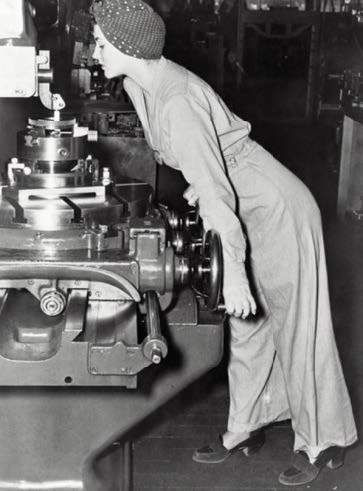On Holding Things Together
Exceptional Parents have to keep their wits, sensibilities, vision, goals, knowledge, stamina and relationships together. They often have to be able to rivet select pieces of their armamentarium together, depending on the terrain, the odds and the outlook. They have to always be ready to flex their muscles and declare, "We Can Do It."
You don' t need an engineering degree from MIT to appreciate that you need something to attach two pieces of metal together. You can bolt them, weld them, glue them, bond them, fuse them, Epoxy them, screw them, magnetize them and, of course probably the oldest method known, you can rivet them. Rivets have been found in archaeological digs dating back to the Bronze Age. Rivets consist of a solid shaft and head that are deformed with a hammer. They lock in the shaft between the two pieces of metal They work like magic. The fact that they were able to hold bridges, swords, towers, ships and monuments together was enough to convince young Levi Strauss that rivets could hold his new canvas pants together. Copper rivets have been holding jeans together ever since. When it came to sticking metal pieces together to make combat airplanes in World War II, it required a little more muscle little more muscle than attaching a back pocket to a pair of jeans. Much of that muscle was supplied by women working in factories making planes, tanks, trucks, ships, weapons and other monstrosities that relied on several pieces of metal being guaranteed to hold together. With able-bodied men going off to do a the fighting, it was necessary for women to do the jobs previously done by men
Nearly 19 million women held jobs during World War II. Women of every race, religion, ethnicity and background worked side by side. They were proud of the work they did. Kirstine Vrooman, a "riveter," shares just how excited she was building B-17 bombers. In the book A Mouthful of Rivets she recalls, "The biggest thrill – I can't tell you – was when the B-17s rolled off the assembly line. You can't believe the feeling


THE REAL ROSIE: When Naomi Parker-Fraley first saw the iconic Rosie the Riveter poster, she recalls, "I did think it looked like me, but nobody ever mentioned it."
we had. We did it." The women working in factories soon became known as "Rosie the Riveter." The name was first used in 1942 in a the fighting, it was necessary for women to do the jobs previously done by men. 4 April 2018 • EP Magazine | ep-magazine.com song of the same name. The majority of working women filled non-factory jobs, but the name convinced many women that they had a patriotic duty to enter the workforce. In addition to the song, the U.S. government created an iconic image of a working woman that appeared on millions of posters and has since become the symbol for the feminist movement.

The strong, no nonsense, bandanna-clad Rosie became one of the most successful recruitment tools in American history and, next to the raising of the flag at Iwo Jima, one of the war's most iconic images.
Naomi Parker Fraley, the real life Rosie the Riveter, died earlier this year at age 96. Born in Tulsa, Oklahoma in 1921, the waitress-turned-factory worker began her job at the Naval Air Station in California and was among the first women to be assigned to the machine shop after the Japanese attack on Pearl Harbor December 1941. According THE REAL ROSIE: When Naomi Parker-Fraley first saw the iconic Rosie the Riveter poster, she recalls, "I did think it looked like me, but nobody ever mentioned it." we had. We did it." The women working in factories soon became known as "Rosie the Riveter." The name was first used in 1942 in a the fighting, it was necessary for women to do the jobs previously done by men. 4 April 2018 • EP Magazine | ep-magazine.com song of the same name. The majority of working women filled non-factory jobs, but the name convinced many women that they had a patriotic duty to enter the workforce. In addition to the song, the U.S. to Karen Mizoguchi (People Human Interest), "In 1942,
20-year-old Fraley posed for a photograph wearing her signature red and white polka dot bandana and working on a turret lathe." Over the years, the true identity of "Rosie" became blurred and she was attributed to several different women. In 2015, a professor of communications (Seton Hall University) knocked on her front door. After six years of research ("Rosie's Secret Identity," Journal of Rhetoric & Public Affairs) he had correctly identified "Rosie the Riveter" as being Ms. Fraley. On the original photograph of Fraley, the photographer wrote the caption, "Pretty Naomi Parker looks like she might catch her nose in the turret lathe she is operating."
"The strong, no-nonsense, bandanna-clad Rosie became one of the most successful recruitment tools in American history and, next to the raising of the flag at Iwo Jima, one of the war's most iconic images."
There is no telling how many millions of pounds of rivets (rivets were measured by the pound, not by the number) Naomi and the sisterhood of Rosie's pulverized into the shape of airplanes, tanks and trucks. Their contribution to the war effort can never be fully appreciated.
Keeping things together is a necessary trait for exceptional parents. They have to keep their wits, sensibilities, vision, goals, knowledge, stamina and relationships together. They often have to be able to rivet select pieces of their armamentarium together, depending on the terrain, the odds and the outlook. They have to always be ready to flex their muscles and declare, "We Can Do It!" Like Rosie, they have always had their rivet guns by their side. •